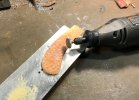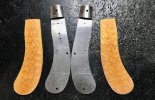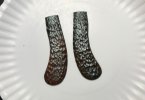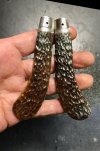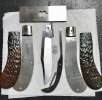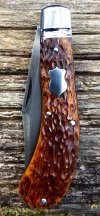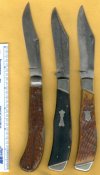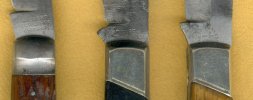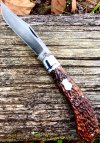You have to have the bone pinned into the liner/bolster assembly before assembling the knife. As long as the dye process doesn't effect the metal in the liner/bolster/pin used you just dye them after fitting/jigging/shaping the scale, but before assembly.
I believe you're at least partially
(or perhaps completely) right. I do think that jigging often occurred much later on very old vintage/antique knives. And, on newer knives, I think custom makers
(that do their own jigging) do their jigging later in the process than one might expect as well. I'm not sure how this relates to dye, but I'll try to tie it all together below.
When everyone started bringing up the bone and jigging and dye, I had a memory of a Tony Bose video that was relevant. I couldn't find it. But, today had better luck. The video below should be timestamped to 22min 15secs.
"Learn this. Look at that piece of bone. That's old Napanoch bone off a slimline trapper. They shaped it and rounded it over on the edges, then jigged it. That's the reason old knives don't have square corners on them. They shaped them before they jigged them."
- Tony Bose
I'm still not certain if Tony Bose was saying this was how he did things or if that was just how this example was done. But, I got the impression Tony Bose did it this way himself.
I think this is confirmed by some of his knives. Their jigging goes all the way to the bolsters; the very edges. However, if you tried to do this jigging after shaping while the bone was still on the liners, you'd end up jigging the bolsters as well. So, my assumption is Tony Bose and old knife manufacturers such as Napanoch first "shaped it and rounded it over on the edges", then removed it from the liners
(my assertion), "then jigged it." If it was already off of the liners, I'd see no reason not to dye it after the jigging was done to ensure you didn't get lighter tones in the jigging. And if dying was done after shaping, you wouldn't get lighter tones on the bone near the bolsters
(save for some lighter tones that might occur when polishing).
I shouldn't have to point this out, but just in case... GEC knives shouldn't be compared to the great knives of the one and only Tony Bose
 EDIT: For example, not my image... but I don't see how Tony Bose could've achieved this jigging before shaping or while the bone was still on the liners. Especially if you look around the bolsters/pins. I also think it would be hard to achieve this result if you dyed before shaping or jigging as the dye is consistent from end-to-end edge-to-edge. This is what leads me to believe that Tony Bose shaped the bone, removed it from the liners, jigged it, dyed it, and then assembled the knife. And, per his quote above, at least some of these steps were performed by very old production knife manufacturers such as Napanoch. This would obviously be too expensive for a factory to do today. So, instead, I believe they jig it, dye it, shape it, and then finish assembling the knife.
EDIT: For example, not my image... but I don't see how Tony Bose could've achieved this jigging before shaping or while the bone was still on the liners. Especially if you look around the bolsters/pins. I also think it would be hard to achieve this result if you dyed before shaping or jigging as the dye is consistent from end-to-end edge-to-edge. This is what leads me to believe that Tony Bose shaped the bone, removed it from the liners, jigged it, dyed it, and then assembled the knife. And, per his quote above, at least some of these steps were performed by very old production knife manufacturers such as Napanoch. This would obviously be too expensive for a factory to do today. So, instead, I believe they jig it, dye it, shape it, and then finish assembling the knife.



